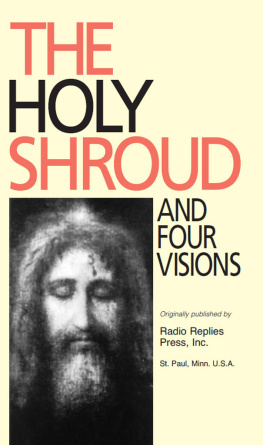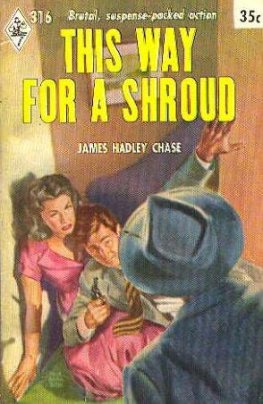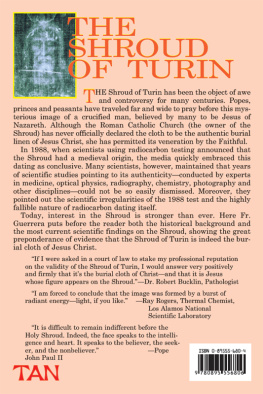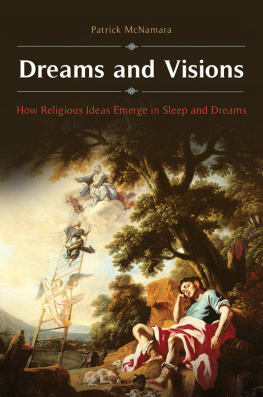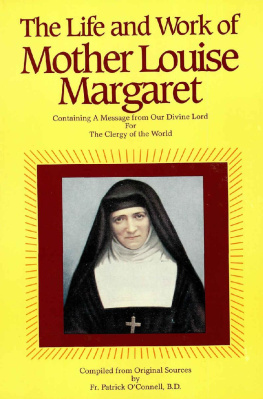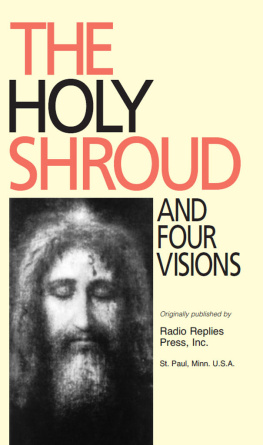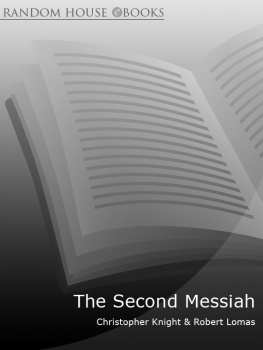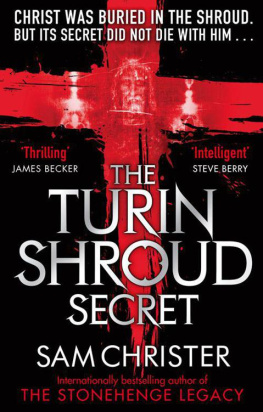Rev. Patrick OConnell - The Holy Shroud and Four Visions
Here you can read online Rev. Patrick OConnell - The Holy Shroud and Four Visions full text of the book (entire story) in english for free. Download pdf and epub, get meaning, cover and reviews about this ebook. year: 2015, publisher: TAN Books, genre: Religion. Description of the work, (preface) as well as reviews are available. Best literature library LitArk.com created for fans of good reading and offers a wide selection of genres:
Romance novel
Science fiction
Adventure
Detective
Science
History
Home and family
Prose
Art
Politics
Computer
Non-fiction
Religion
Business
Children
Humor
Choose a favorite category and find really read worthwhile books. Enjoy immersion in the world of imagination, feel the emotions of the characters or learn something new for yourself, make an fascinating discovery.
- Book:The Holy Shroud and Four Visions
- Author:
- Publisher:TAN Books
- Genre:
- Year:2015
- Rating:4 / 5
- Favourites:Add to favourites
- Your mark:
- 80
- 1
- 2
- 3
- 4
- 5
The Holy Shroud and Four Visions: summary, description and annotation
We offer to read an annotation, description, summary or preface (depends on what the author of the book "The Holy Shroud and Four Visions" wrote himself). If you haven't found the necessary information about the book — write in the comments, we will try to find it.
The Holy Shroud and Four Visions — read online for free the complete book (whole text) full work
Below is the text of the book, divided by pages. System saving the place of the last page read, allows you to conveniently read the book "The Holy Shroud and Four Visions" online for free, without having to search again every time where you left off. Put a bookmark, and you can go to the page where you finished reading at any time.
Font size:
Interval:
Bookmark:
THE
HOLY SHROUD
AND
FOUR VISIONS
The Holy Shroud New Evidence Compared with the Visions of St. Bridget of Sweden, Maria dAgreda, Catherine Emmerich, and Teresa Neumann.
Rev. Patrick OConnell, B.D. Columban Fathers, Dalgan Park Navan, Ireland. And Rev. Charles Carty Radio Replies Press Society St. Paul 1, Minn., U. S. A.
| Imprimatur: | Joannes Gregorius Murray |
| Archiepiscopus Sancti Pauli |
Cover picture of this pamphlet: Bruners Interpretation of the Holy Face.
Copyright 1974 by TAN Books.
Originally published by Fathers Rumble and Carty, Radio Replies Press, Inc., St. Paul, MN, U.S.A.
The type in this book is the property of TAN Books, and may not be reproduced, in whole or in part, without written permission of the publisher.
Complete and Unabridged.
TAN Books
Charlotte, North Carolina
www.TANBooks.com
2010
CONTENTS
PREFACE
For the composition of this booklet the following books were consulted: New Light on the Passion of Our Divine Lord by Rev. Patrick OConnell, B.D. Columban Fathers, Dalgan Park, Navan, Ireland. Le Saint Suaire de Turin by Dr. Paul Vignon (latest edition 1939), Les Cinq Plaies by Dr. Barbet, Le Christ Dans Sa Passion Revele Par Le Saint Suaire de Turin by Gerard Cordonnier, Golgotha by Dr. Hynek; three articles by Fr. Wuenschel, C. SS. R. in American Ecclesiastical Review 1953; The Holy Shroud by Dr. Beecher; four articles in Revue Metaphysique 1938; La Santa Sindone Rivelata Dalla Fotografia by Cav. G. Enrie; The Burial of Christ by Professor Alfred ORahilly; The Holy Shroud of Jesus Christ by Lieut-Colonel P. W. Gorman; The Holy Shroud of Turin by Stella Bellars; La S. Sindone by Dr. Luigi Lovera Di Maria; A Doctor at Calvary by Dr. Pierre Barbet, Fr. Wuenschels latest book, Self-Portrait of Christ and the principal books of St. Bridget of Sweden, Venerable Maria dAgreda, Anne Catherine Emmerich and Teresa Neumann have also been consulted.
The object of this pamphlet is to throw light on the visions of the Passion from the evidence of the Holy Shroud and to show that the sufferings of Our Divine Lord in His Passion were far greater than they are generally represented in sermons and books.
We hold that the image on the Holy Shroud which records in minute detail the terrible story of the Passion is not the result of accident but the work of Providence.
Two events occurred towards the close of the last century which rescued the Shroud from the tomb of oblivion in which it was lying in its shine at Turin and led to a thorough investigation of its history, of the image upon it, of how it was formed and of what the image reveals. These two events were first; the discovery by Canon Ulisses Chevalier of evidence that a copy of the Shroud had been painted back about 1350, which started a controversy as to whether this painted copy and the Shroud of Turin were identical, and second; the taking of the first photograph of the Shroud by Secundo Pia in 1898.
When the Shroud was exposed for veneration in 1931 and 1933, doctors and other scientists endorsed the verdict of the French scientists that the Holy Shroud of Turin was Not a Painting , but truly the Shroud in which Joseph and Nicodemus wrapped the Body of Our Lord.
The following statement of Pope Pius XI was published in the Osservatore Romano on Sept. 7, 1936: The Holy Shroud of Turin is still mysterious, but it is certainly not the work of any human hand. This, one can now say, is demonstrated. We said mysterious, because the sacred object still involves many problems, but certainly it is more sacred than perhaps any other; and, as is now established in the most positive way, even apart from any idea of faith or Christian piety, it is certainly not a human work. In all, thirty-three Popes have spoken in favor of the Shroud, among whom are Leo XIII, Pius, X, Pius XI, and Pius XII.
History of the Holy Shroud
The following is the combined account of the Four Evangelists and the Holy Shroud; Joseph of Arimathea bought a length of linen sufficient to make the shroud mentioned by the Synoptics and to furnish the linen cloths mentioned by St. John. He then cut off about fourteen feet and a half for the Shroud that was to cover the body from head to foot, front and back, and divided the remainder into two or three lengths to go around the body outside the Shroud. He next stretched the fourteen and a half feet length on the ground, sprinkled the myrrh and aloes over it and laid the body of Our Lord upon it with the Head towards the middle and the feet about a foot and a half from one end. He turned this foot and a half over Our Lords feet and legs halfway up to the knees. (We know that this was done because there is no image of the front of the feet on the Shroud. This foot and a half has disappeared having probably been given away by the Emperor of Constantinople as a relic). He then drew the other end over the head and covered the front of the body including the feet. (On this front portion there is only the mark of blood which flowed from the feet). Both from St. John and from the Shroud itself we infer that the Shroud was not left loose: St. John says that they bound the body of Jesus in linen cloths, and the image on the Shroud shows that it was in close contact with the body except in a few placesthe neck and the front of the shoulders. These bands or pieces of linen have disappeared.
In his account of the burial, St. John does not refer expressly to the Shroud, but in his account of the linens found in the tomb after the Resurrection he refers to two kinds. He says that the Beloved Disciple and St. Peter saw the linen cloths (which had been around the body) lying (this, we may presume, means that they had not been untied); but the Sudarium that had been about His head (or drawn over the head) not lying with the other cloths but apart, wrapped up in one place. It is highly probable that this piece of linen which St. John singles out for mention, and which Our Lord Himself detached from the other linens, folded up and laid apart, was the Holy Shroud.
St. John says that the burial of Our Lord was carried out according to the manner of the Jews, but this does not mean that the Jewish manner of burial was absolutely uniform, or that everything done at a Jewish burial was carried out. The Shroud shows that the Jewish custom of passing a cloth under the chin and tying it on top of the head was carried out, for there is a gap in the image of the head on the Shroud where it passed over the knot; the Jewish custom of stretching out the fingers and turning the thumbs into the palm of the hand was also observed. The use of the shroud itself and the way it was tied was also a Jewish custom except among the poor who were buried in their clothes. The body of Our Lord was not anointed, Mary Magdalen had anointed it for His burial, nor was the body washed.
Brief History of the Holy Shroud
No reference to the Holy Shroud has so far been found in early Christian literature during the first three centuries of persecution. There were many reasons for the silence. Any reference to it might lead to its discovery by the enemies of Christianity. Besides, during these three centuries of persecution while the cross was still used as an instrument for the execution of slaves and criminals, it was forbidden by the Ecclesiastical authorities to paint or display an image of Christ on the Cross. This prohibition would virtually extend to the exhibition of the Holy Shroud which gives a vivid representation of the whole Passion with its most terrible and humiliating details. It was not until 692 A.D. that the Council of Constantinople decreed that the image of Christ Himself represented alive on the Cross should replace the image of the Lamb. It was not until the tenth century that permission was given to represent Him dead on the Cross.
Next pageFont size:
Interval:
Bookmark:
Similar books «The Holy Shroud and Four Visions»
Look at similar books to The Holy Shroud and Four Visions. We have selected literature similar in name and meaning in the hope of providing readers with more options to find new, interesting, not yet read works.
Discussion, reviews of the book The Holy Shroud and Four Visions and just readers' own opinions. Leave your comments, write what you think about the work, its meaning or the main characters. Specify what exactly you liked and what you didn't like, and why you think so.

